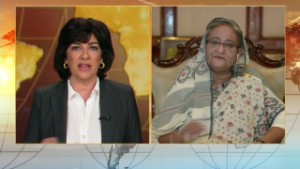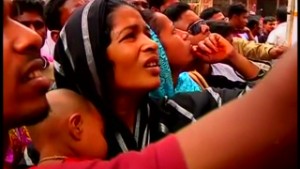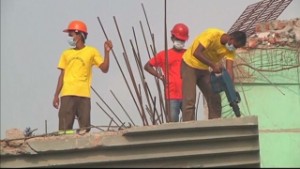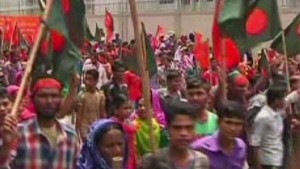Somewhere high above the clouds over Africa, in seat number 17K, Laura Sherburne learned the awful news of the Boston bombings.
She was supposed to have been there, right at the finish line, captain of a team of volunteer nurses who triage exhausted runners in medical tents. She’d done it last year and signed up again.
But shortly before the race, Sherburne learned she had won an international fellowship and would have to be on a plane the day of the marathon. She cajoled her friend Jane Keefe Chiang to take over the nurses team.
Panic set in on that never-ending Emirates flight from New York after she caught a news flash on an in-flight channel. “Deadly explosion at Boston Marathon finish line.”
There was so little information at first. She imagined the worst.
 Bangladesh’s PM speaks out about tragedy
Bangladesh’s PM speaks out about tragedy Did Bangladesh refuse aid offers?
Did Bangladesh refuse aid offers? Calls for action after factory collapse
Calls for action after factory collapse The ache turned to guilt that she wasn’t there to help — guilt squared because she was a nurse.
As her plane landed, Sherburne’s head was an emotional cocktail: grief, anger and anxiety, mixed with excitement of being in a foreign land.
It was all about to magnify.
She’d arrived in Bangladesh, one week before that nation’s worst industrial tragedy. She did not have to witness the horror in her hometown. But 8,653 miles away, she would not be spared.
A medical mission half a world away
Sherburne, 25, made the journey to Bangladesh with Maryanne Meadows, a neurosurgery nurse she’d befriended at Simmons College in Boston. After nursing school, the two women went to work at Massachusetts General Hospital, where many of the bombing victims were treated.
The pair were part of a rotating team the hospital has been sending to Dhaka to help set up the first bone marrow transplant unit in Bangladesh. Massachusetts General has 60 health projects in 40 countries. The Bangladesh government had approached the hospital to help set up the facility, scheduled to open around August.
Sherburne had never traveled to South Asia before. She experienced the shock that almost every Westerner does after leaving the airport. The assault of hot, heavy, damp air. The unsightly piles of garbage tossed in heaps in open lots, their stench mingling with the heady smells of mustard oil and onion from cooking on the streets.
At her apartment, palmetto bugs scurried across the living room floor and geckos shuttled along the walls.
She might have been reeling from it all had Boston not filled her mind.
After she saw the news on the plane, she’d woken up Meadows, and the two immediately purchased in-flight Wi-Fi so they could get on e-mail and Facebook and check on their friends and family.
Luckily, everyone seemed to be fine.
 Why Bangladesh said no to aid
Why Bangladesh said no to aid The true cost of producing a T-shirt
The true cost of producing a T-shirt Pressure on Bangladesh over labor
Pressure on Bangladesh over labor“It was really hard. I was just trying to focus, but it just kept getting worse,” she said. Her brother lives in Watertown, where police finally caught up with bombing suspect Dzhokhar Tsarnaev.
Through it all, Sherburne was so immersed in the news that she almost forgot she was not actually in Boston. That she hadn’t just had a Dunkin’ Donuts coffee or gone for a jog along the Charles River.
In her first post on her new blog, “What Would Flo Do?” (named after Florence Nightingale), Sherburne wrote this:
“Given the horrific scenes of Monday, followed by the conclusive events on Friday, my head and heart are still somewhere lost over the Atlantic,” she wrote. “I hope, however, to slowly drift back to the Bay of Bengal shores and the work at hand.”
Welcome to Bangladesh
She and Meadows settled into their apartment in the neighborhood of Baridhara, which Sherburne described as the Beacon Hill of Bangladesh. It lacks the swank of blue-blood Boston but for Dhaka, it is a luxury. She even has remote-controlled air conditioning and a maid, Shilipi, who cleans and cooks for the two Americans.
Her father had worried so much about his daughter traveling to Bangladesh. The worries heightened after deadly riots erupted over a war crimes tribunal trying Islamist leaders for crimes committed during the nation’s 1971 war for independence, when it was known as East Pakistan. Still, he’d been glad to hear his daughter’s voice from the other side of the world. Thank God she wasn’t on the finish line that day in Boston.
On some days, Sherburne and Meadows found themselves in lockdown in their new home because of security concerns. The opposition party, allied with Islamists, has been calling for nationwide strikes, and tensions have led to violent clashes on the streets. But the nurses were eager to get started with the work at hand.
The challenge of launching a bone marrow transplant unit seemed even greater when Bangladesh decided to put it in a public institution: Dhaka Medical College Hospital.
Sherburne had signed up to do this because she wanted to be out of her comfort zone and to be able to remember always how lucky she was to be at Massachusetts General.
She was reminded the moment she walked into Dhaka Medical.
The hospital has 1,700 beds but on any given day, there could be as many as 4,000 patients sharing beds and spilling into hallways and stairwells. That’s not uncommon for public hospitals in this part of the world. They are the only places where desperately poor people can afford medical care.
Sherburne’s skills might even make her a doctor at the Dhaka hospital. Some nurses are barely one step above a maid. That’s what a doctor told Sherburne upon her arrival.
She’d never been in a hospital so ill-equipped to treat severe cases. In Boston, she changed her latex gloves after seeing each patient. In Dhaka, the hospital could not afford so many gloves, so the nurses used one pair on several patients.
She was appalled by the workload of the nurses; each averaged 25 to 30 patients. In America, that number would likely be somewhere between four and eight.
Sherburne and Meadows began their lectures and their clinical training of 10 nurses.
A horrific industrial accident
On the morning of April 24, the two American women were advised to stay at home. A hartal, the Bengali word for a strike, had been called for that day, and there was potential for more strife.
But the employees at the garment factories housed in Rana Plaza in suburban Savar were exempt from the strike. They were ordered to work, even after an inspection the previous day found cracks in the nine-story building and the structure was deemed dangerous.
Shortly after thousands of men, women, boys and girls showed up that day, the building came tumbling down. They were trapped under a crush of mangled concrete and steel.
Sherburne received a U.S. State Department alert about the building collapse.
“When Boston happened, it was so hard not to be at the scene,” she said Thursday from Dhaka. “When this happened, I said, ‘Take me to the hospital.’ “
But she couldn’t leave because of the security risks. Stuck in her home, she watched tragedy unfold again on television.
“My heart hasn’t stopped breaking,” she said.

She watched as rescue workers pulled out survivors, as time grew short. She knew that after 72 hours, there was little chance of a person surviving without food and water. The death toll would eventually rise to more than 400.
She watched as the plight of the workers became public again; how so many worked under terrible conditions for paltry salaries.
And she watched as a 17-year-old girl was interviewed on a TV station. Rescuers had to amputate her arm to slide her out of the rubble.
When Sherburne was 17, she dreaded Saturdays when she worked a four-hour shift at a dry cleaning shop and made $40. Now, it was difficult to watch the teenage survivor.
“The station called her lucky, and I went numb thinking how at age 17, I would have defined lucky,” Sherburne wrote.
“It would have incorporated more than a minimum wage of $38 a month, it would have indicated that if a building was deemed unsafe on a Tuesday, I would not have been forced to return on a Wednesday, and without question it would have included two hands.”
Later she questioned why tragedy in her hometown was incessantly on the news but the headlines from Bangladesh had already started to fade even before the rescue operation was over.
“I could tell you more about how much the Boston Marathon bombers’ mother shoplifted from a Natick, Massachusetts, mall than how many factory workers were still missing.”
Finally released to help
Five days after the catastrophe, Sherburne was allowed out of her house. She went to Dhaka Medical, which had taken in so many of the injured, some now without limbs, some still in life-threatening situations.
She was about to see what she didn’t have to in Boston.
She walked into a ward with 53 female patients, their beds pressed together to make room for them all. It was 101 degrees that day, and the electricity was off because of a national grid problem. Some parts of the vast hospital were dark; others parts were dimly lit by emergency generators.
Sherburne wanted to change the patients’ dressings, but there wasn’t enough bandaging material to do that. So she did what nurses are trained to do. She sat on their beds and comforted them, speaking through a translator.
“How’s your pain?” she asked.
“No pain,” one said. “Nice to meet you.”
For Sherburne, it was another reminder of human resilience.
Each patient mumbled a number. Three. Five. Eight. At first Sherburne didn’t understand why.
Then it hit her. They were telling her which floor they had been on when the building hurtled toward the earth.
She reached out and held a woman’s hand and noticed they were both wearing the same shade of pink on their nails. They even had identical chips in the polish.
“That’s when it stopped seeming American to Bangladeshi and (it) was just a young woman to (another) young woman,” Sherburne wrote.
She walked out with the realization that the clothes she was wearing might have been made in one of those factories that collapsed.
She remembers someone asking her if she wanted to see the dead — the ones who had been brought to hospital but did not survive.
Sherburne declined, politely, but caught a glimpse of a lifeless body being wheeled away. She figured the woman was around her own age.
Source: CNN









